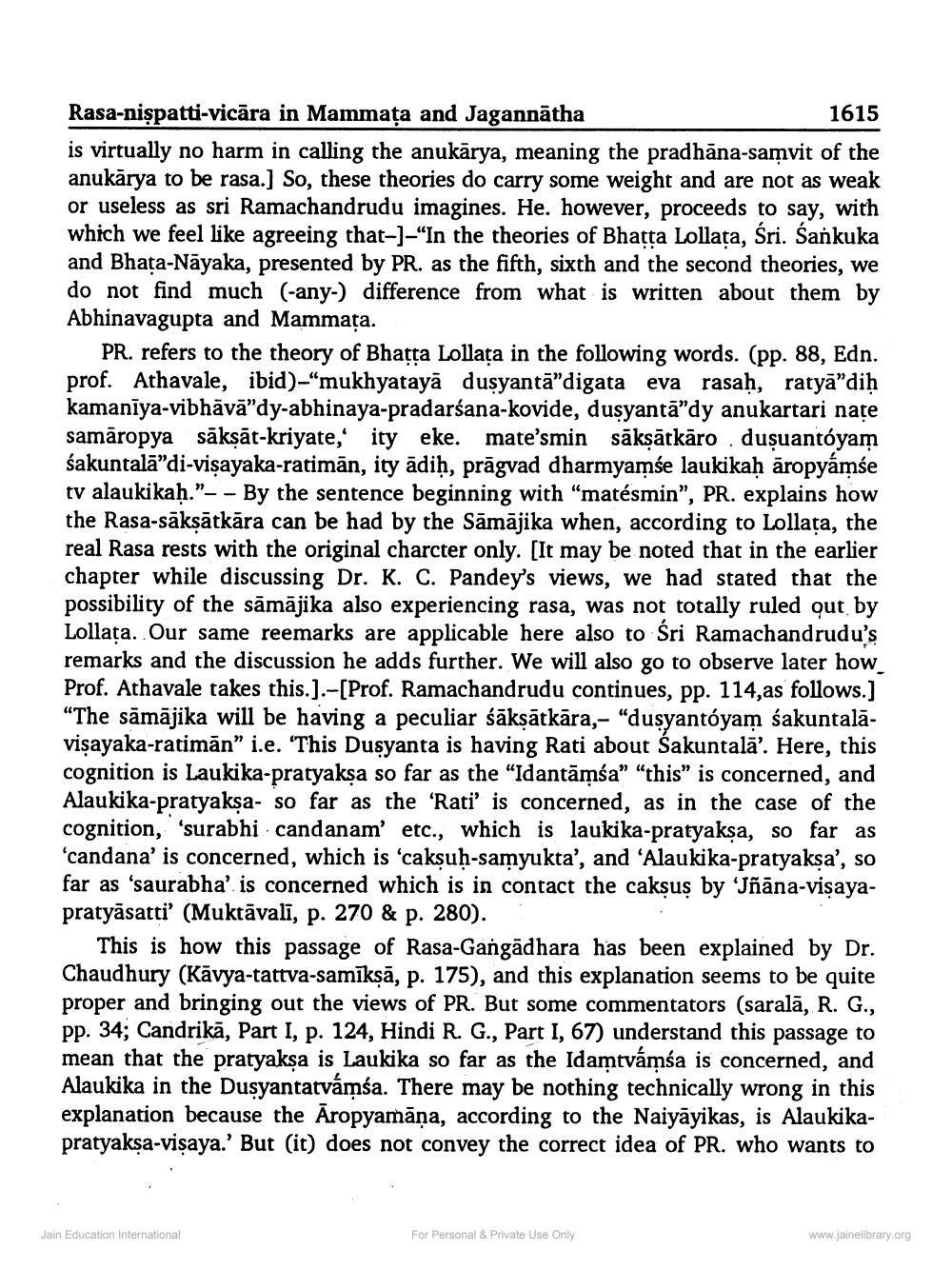________________
Rasa-niṣpatti-vicāra in Mammața and Jagannatha
1615
is virtually no harm in calling the anukārya, meaning the pradhana-samvit of the anukarya to be rasa.] So, these theories do carry some weight and are not as weak or useless as sri Ramachandrudu imagines. He. however, proceeds to say, with which we feel like agreeing that-]-"In the theories of Bhatta Lollata, Śri. Śankuka and Bhața-Nayaka, presented by PR. as the fifth, sixth and the second theories, we do not find much (-any-) difference from what is written about them by Abhinavagupta and Mammata.
PR. refers to the theory of Bhatta Lollata in the following words. (pp. 88, Edn. prof. Athavale, ibid)-"mukhyataya duṣyanta"digata eva rasaḥ, ratyā"diḥ kamanīya-vibhāvā"dy-abhinaya-pradarśana-kovide, duṣyantā❞dy anukartari nate samāropya sākṣāt-kriyate,' ity eke. mate'smin sākṣātkāro duşuantóyam śakuntala"di-viṣayaka-ratiman, ity ādiḥ, prāgvad dharmyamse laukikaḥ āropyámse tv alaukikaḥ."-- By the sentence beginning with "matésmin", PR. explains how the Rasa-sākṣātkāra can be had by the Sāmājika when, according to Lollata, the real Rasa rests with the original charcter only. [It may be noted that in the earlier chapter while discussing Dr. K. C. Pandey's views, we had stated that the possibility of the sāmājika also experiencing rasa, was not totally ruled out by Lollata. Our same reemarks are applicable here also to Sri Ramachandrudu's remarks and the discussion he adds further. We will also go to observe later how Prof. Athavale takes this.].-[Prof. Ramachandrudu continues, pp. 114,as follows.] "The sāmājika will be having a peculiar śākṣātkāra,- "duṣyantóyam śakuntalaviṣayaka-ratimān" i.e. "This Duṣyanta is having Rati about Sakuntala'. Here, this cognition is Laukika-pratyakṣa so far as the "Idantāmsa" "this" is concerned, and Alaukika-pratyakṣa- so far as the 'Rati' is concerned, as in the case of the cognition, 'surabhi candanam' etc., which is laukika-pratyakṣa, so far as 'candana' is concerned, which is 'cakṣuḥ-samyukta', and 'Alaukika-pratyaksa', so far as 'saurabha' is concerned which is in contact the cakṣus by 'Jñana-viṣayapratyāsatti' (Muktāvalī, p. 270 & p. 280).
This is how this passage of Rasa-Gangadhara has been explained by Dr. Chaudhury (Kavya-tattva-samīkṣā, p. 175), and this explanation seems to be quite proper and bringing out the views of PR. But some commentators (saralā, R. G., pp. 34; Candrikā, Part I, p. 124, Hindi R. G., Part I, 67) understand this passage to mean that the pratyakṣa is Laukika so far as the Idamtvámśa is concerned, and Alaukika in the Dusyantatvámśa. There may be nothing technically wrong in this explanation because the Aropyamāṇa, according to the Naiyāyikas, is Alaukikapratyakṣa-visaya.' But (it) does not convey the correct idea of PR. who wants to
Jain Education International
For Personal & Private Use Only
www.jainelibrary.org




